Giorgione (1477 — 1510)
Get a Giorgione Certificate of Authenticity for your painting (COA) for your Giorgione drawing.
For all your Giorgione artworks you need a Certificate of Authenticity (COA) in order to sell, to insure or to donate for a tax deduction.
Getting a Giorgione Certificate of Authenticity (COA) is easy. Just send us photos and dimensions and tell us what you know about the origin or history of your Giorgione painting or drawing.
If you want to sell your Giorgione painting or drawing use our selling services. We offer Giorgione selling help, selling advice, private treaty sales and full brokerage.
We have been authenticating Giorgione and issuing certificates of authenticity since 2002. We are recognized Giorgione experts and Giorgione certified appraisers. We issue COAs and appraisals for all Giorgione artworks.
Our Giorgione paintings and drawings authentications are accepted and respected worldwide.
Each COA is backed by in-depth research and analysis authentication reports.
The Giorgione certificates of authenticity we issue are based on solid, reliable and fully referenced art investigations, authentication research, analytical work and forensic studies.
We are available to examine your Giorgione painting or drawing anywhere in the world.
You will generally receive your certificates of authenticity and authentication report within two weeks. Some complicated cases with difficult to research Giorgione paintings or drawings take longer.
Our clients include Giorgione collectors, investors, tax authorities, insurance adjusters, appraisers, valuers, auctioneers, Federal agencies and many law firms.
We perform Giorgione art authentication. appraisal, certificates of authenticity (COA), analysis, research, scientific tests, full art authentications. We will help you sell your Giorgione or we will sell it for you.

Giorgione, the familiar name of Giorgio Barbarelli da Castelfranco, was an Italian painter, one of the seminal artists of the High Renaissance in Venice. Giorgione is known for the elusive poetic quality of his work, and for the fact that only very few (around six) paintings are known for certain to be his work. The resulting uncertainty about the identity and meaning of his art has made Giorgione one of the most mysterious figures in European painting.
Giorgione’s life is described in Giorgio Vasari’s Vite. The painter came from the small town of Castelfranco Veneto, outside Venice. His name sometimes appears as Zorzo. The variant Giorgione (or Zorzon) may be translated “Big George”. How early in boyhood he went to Venice we do not know, but internal evidence supports the statement of Ridolfi that he served his apprenticeship there under Giovanni Bellini; there he settled and made his fame.
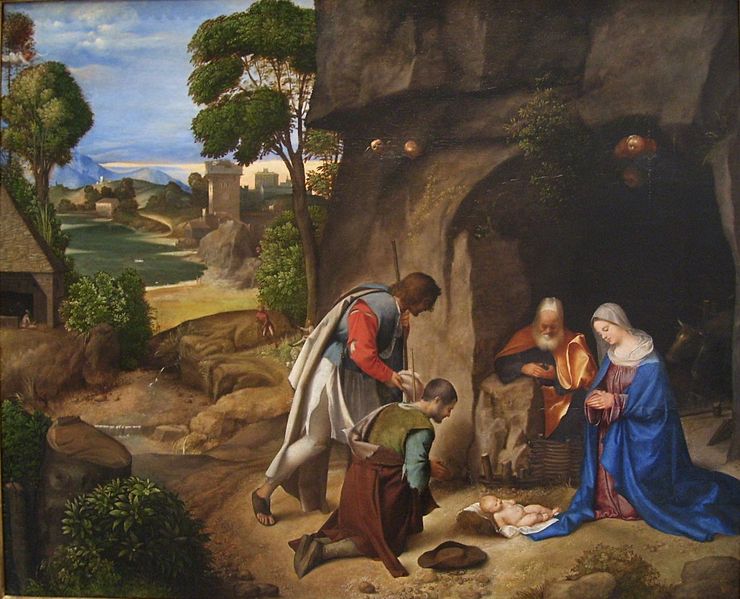
Contemporary documents record that his gifts were recognized early. In 1500, when he was only twenty-three (that is, if Vasari gives rightly the age at which he died), he was chosen to paint portraits of the Doge Agostino Barberigo and the condottiere Consalvo Ferrante. In 1504 he was commissioned to paint an altarpiece in memory of Matteo Costanzo in the cathedral of his native town, Castelfranco. In 1507 he received at the order of the Council of Ten part payment for a picture (subject not mentioned) on which he was engaged for the Hall of the Audience in the Doge’s Palace. In 1507-1508 he was employed, with other artists of his generation, to decorate with frescoes the exterior of the newly rebuilt Fondaco dei Tedeschi (or German Merchants’ Hall) at Venice, having already done similar work on the exterior of the Casa Soranzo, the Casa Grimani alli Servi and other Venetian palaces.
Vasari gives also as an important event in Giorgione’s life, and one which had influence on his work, his meeting with Leonardo da Vinci on the occasion of the Tuscan master’s visit to Venice in 1500. In September or October 1510 he died of the plague then raging in the city, and within a few days of his death we find the great art-patroness and amateur, Isabella d’Este, writing from Mantua and trying in vain to secure for her collection a nocturne by his hand.
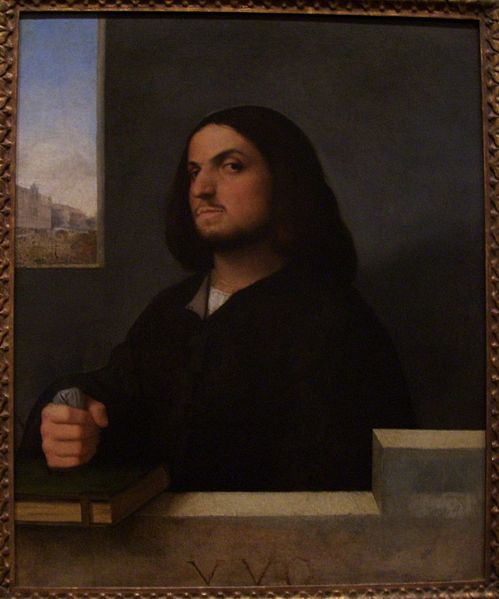
All accounts agree in representing Giorgione as a person of distinguished and romantic charm, a great lover and musician, given to express in art the sensuous and imaginative grace, touched with poetic melancholy, of the Venetian existence of his time. They represent him further as having made in Venetian painting an advance analogous to that made in Tuscan painting by Leonardo more than twenty years before; that is, as having released the art from the last shackles of archaic rigidity and placed it in possession of full freedom and the full mastery of its means.
Giorgione also introduced a new range of subjects. Besides altarpieces and portraits he painted pictures that told no story, whether biblical or classical, or if they professed to tell such, neglected the action and simply embodied in form and color moods of lyrical or romantic feeling, much as a musician might embody them in sounds. Innovating with the courage and felicity of genius, he had for a time an overwhelming influence on his contemporaries and immediate successors in the Venetian school, including Titian, Sebastiano del Piombo, Palma il Vecchio, il Cariani, Giulio Campagnola (and his brother), and even on his already eminent master, Giovanni Bellini. In the Venetian mainland, Giorgionismo strongly influenced Morto da Feltre, Domenico Capriolo, and Domenico Mancini.
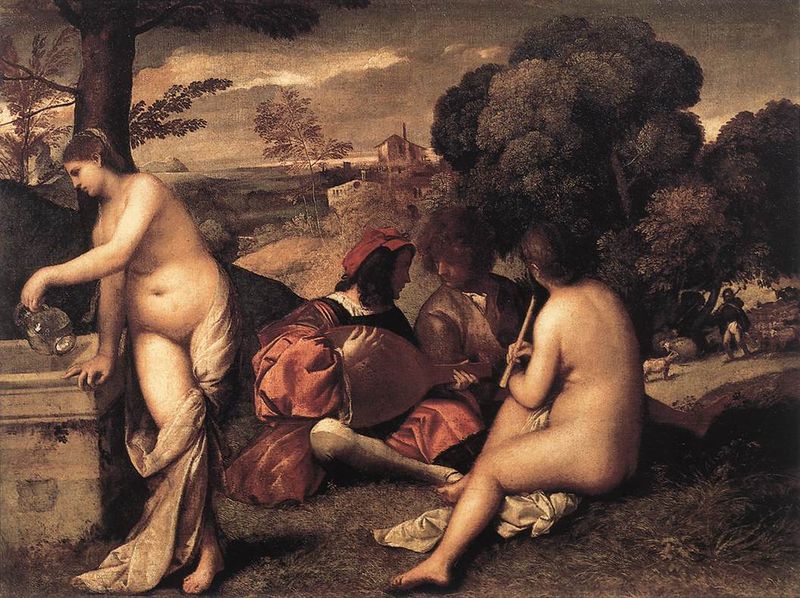
His name and work have exercised, and continue to exercise, no less a spell on posterity. But to identify and define, among the relics of his age and school, precisely what that work is, and to distinguish it from the kindred work of other men whom his influence inspired, is a very difficult matter. There are inclusive critics who still claim for Giorgione nearly every painting of the time that at all resembles his manner, and there are exclusive critics who pare down to half a dozen the list of extant pictures which they will admit to be actually his.
While still in Castelfranco, Giorgione painted the Castelfranco Madonna, a fairly conventional sacra conversazione piece — Madonna enthroned, with saints on either side forming an equilateral triangle. However, the romantic richness of the landscape in the background marks an innovation in Venetian art. Giorgione discovered sfumato or chiaroscuro — the delicate use of shades of color to depict light and perspective — around the same time as Leonardo. His delicate color modulations result from the tiny disconnected spots of paint that he probably derived from manuscript illumination techniques and first brought into oil painting. These gave Giorgione’s works the magical glow of light for which they are famous.

Most entirely central and typical of all Giorgione’s extant works is the Sleeping Venus at Dresden, first recognized by Morelli, and now universally accepted, as being the same as the picture seen by the Anonimo and later by Ridolfi in the Casa Marcello at Venice. An exquisitely pure and severe rhythm of line and contour chastens the sensuous richness of the presentment: the sweep of white drapery on which the goddess lies, and of glowing landscape that fills the space behind her, most harmoniously frame her divinity. The use of an external landscape to frame a nude is innovative; but in addition, to add to her mystery, she is shrouded in sleep, spirited away from accessibility to her conscious expression.
It is recorded that the master left this piece unfinished and that the landscape, with a Cupid which subsequent restoration has removed, were completed after his death by Titian. The picture is the prototype of Titian’s own Venus of Urbino and of many more by other painters of the school; but none of them attained the fame of the first exemplar. The same concept of idealized beauty is evoked in a virginally pensive Judith from the Hermitage Museum, a large painting which exhibits Giorgione’s special qualities of color richness and landscape romance, while demonstrating that life and death are each other’s companions rather than foes.
The Tempest has been called the first landscape in the history of Western painting. The subject of this painting is unclear, but its artistic mastery is apparent. The Tempest portrays a soldier and a breast-feeding woman on either side of a stream, amid a city’s rubble and an incoming storm. The multitude of symbols in The Tempest offer many interpretations, but none is wholly satisfying. Theories that the painting is about duality (city and country, male and female) have been dismissed since radiography has shown that in the earlier stages of the painting the soldier to the left was a seated female nude.
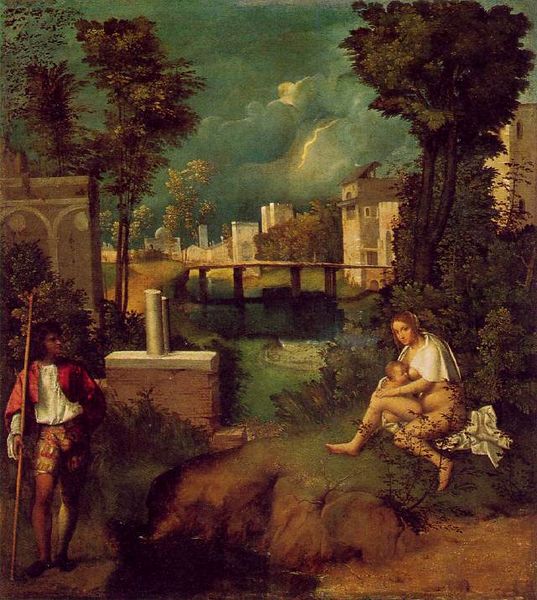
The Three Philosophers is equally enigmatic and its attribution to Giorgione is still disputed. The three figures stand near a dark empty cave. Sometimes interpreted as symbols of Plato’s cave or the Three Magi, they seem lost in a typical Giorgionesque dreamy mood, reinforced by a hazy light so characteristic of his other landscapes, such as the Pastoral Concert, now in the Louvre. The latter “reveals the Venetians’ love of textures”, for the painter “renders almost palpable the appearance of flesh, fabric, wood, stone, and foliage”. The painting is devoid of harsh contours and its treatment of landscape has been frequently compared to pastoral poetry, hence the title.
Giorgione and young Titian revolutionized the genre of the portrait as well. It is exceedingly difficult and sometimes simply impossible to differentiate Titian’s early pieces from Giorgione’s. The only signed and dated work by Giorgione is his portrait of Laura (1 June 1506), one of the first to be painted in the “modern manner”, distinguished by dignity, clarity, and sophisticated characterization. Even more striking is the Portrait of a Young Man from Munich (ca. 1504), acclaimed by art historians for “the indescribably subtle expression of serenity and the immobile features, added to the chiseled effect of the silhouette and modeling”.
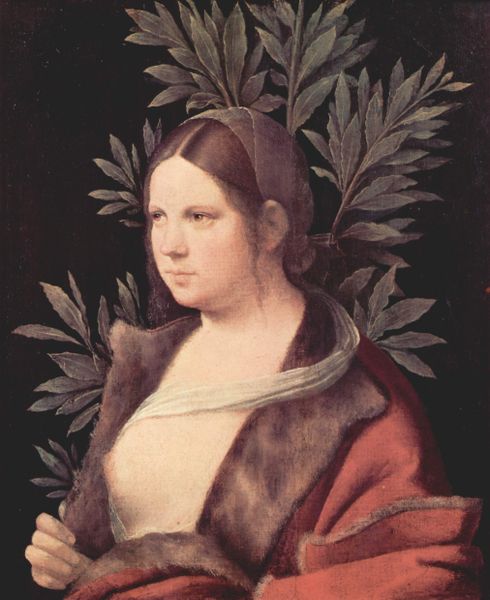
Though he died at the young age of 33, the precocious and versatile painter left a lasting legacy to be developed by Titian and 17th-century artists. Giorgione never subordinated line and colour to architecture, nor an artistic effect to a sentimental presentation. He was the first to paint landscapes with figures, the first to paint genre — movable pictures in their own frames with no devotional, allegorical, or historical purpose — and the first whose colours possessed that ardent, glowing, and melting intensity which was so soon to typify the work of all the Venetian School.
Kunsthistorisches Museum, Vienna
- Judith (c. 1504) – Oil on canvas, transferred from panel, 144 x 66,5 cm, Hermitage Museum, St. Petersburg
- Madonna and Child Enthroned between St. Francis and St. Nicasius (c. 1505) – Oil on wood, 200 x 152 cm, Duomo, Castelfranco Veneto
- The Tempest (c. 1505) – Oil on canvas, 82 x 73 cm, Accademia, Venice
- Pastoral Concert (c. 1508) – Oil on canvas, 110 x 138 cm, Louvre, Paris
- Portrait of a Young Bride (Laura) (c. 1506) Oil on wood, 41 x 33,5 cm, Kunsthistorisches Museum, Vienna
- Old Woman (c. 1508) – Oil on canvas, 68 x 59 cm, Accademia, Venice
- Portrait of a Youth (1508-10) – Oil on canvas, 72,5 x 54 cm, Museum of Fine Arts, Budapest
- The Three Philosophers (1509) – Oil on canvas, Kunsthistorisches Museum, Vienna
- Portrait of Warrior with his Equerry (c. 1509) – Oil on canvas, 90 x 73 cm, Galleria degli Uffizi, Florence
- Sleeping Venus (c. 1510) – Oil on canvas, 108,5 x 175 cm, Gemäldegalerie, Dresden
- The Impassioned Singer (c. 1510) – Oil on canvas, 102 x 78 cm, Galleria Borghese, Rome
- Portrait of a Young Man – Wood, 69,4 x 53,5 cm, Alte Pinakothek, Munich
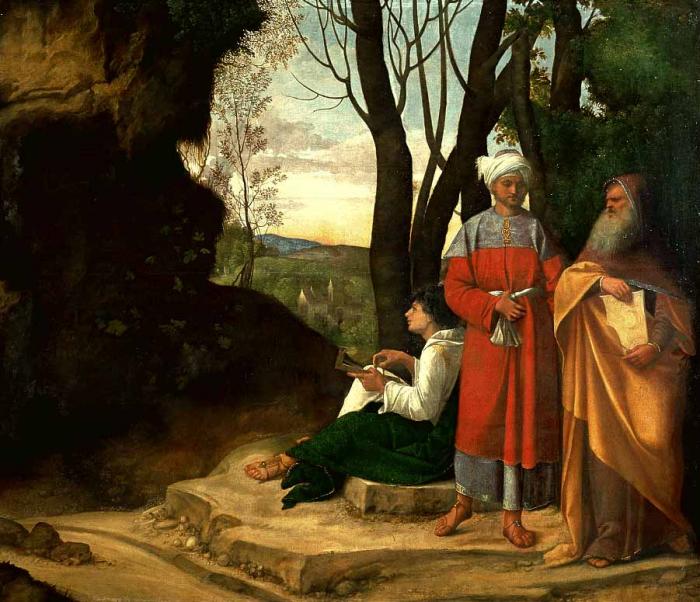
Still wondering about an Italian painting in your family collection? Contact us…it could be by Giorgione.
Reviews
1,217 global ratings
5 Star
4 Star
3 Star
2 Star
1 Star
Your evaluation is very important to us. Thank you.
